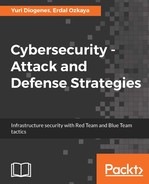Although the incident response process will vary according to the company and its needs, there are some fundamental aspects of it that will be the same across different industries.
The following diagram shows the foundational areas of the incident response process:

The first step to create your incident response process is to establish the objective—in other words, to answer the question: What's the purpose of this process? While this might look redundant, as the name seems to be self-explanatory, it is important that you are very clear as to the purpose of the process so that everyone is aware of what this process is trying to accomplish.
Once you have the objective defined, you need to work on the scope. Again, you start this by answering a question, which in this case is: To whom does this process apply?
Although the incident response process usually has a company-wide scope, it can also have a departmental scope in some scenarios. For this reason, it is important that you define whether this is a company-wide process or not.
Each company may have a different perception of a security incident; therefore, it is imperative that you define what constitutes a security incident, and give examples.
Along with the definition, companies must create their own glossary with definitions of the terminology used. Different industries will have different sets of terminologies, and if these terminologies are relevant to a security incident, they must be documented.
In an incident response process, the roles and responsibilities are critical. Without the proper level of authority, the entire process is at risk.
The importance of the level of authority in an incident response is evident when you consider the question: Who has the authority to confiscate a computer in order to perform further investigation? By defining the users or groups that have this level of authority, you are ensuring that the entire company is aware of this, and if an incident occurs, they will not question the group that is enforcing the policy.
What defines a critical incident? How are you going to distribute your manpower when an incident occurs? Should you allocate more resources to incident "A" versus incident "B"? Why? These are only some examples of questions that should be answered to define the priorities and severity level.
To determine the priority and severity level, you will need to also take into consideration the following aspects of the business:
- Functional impact of the incident in the business: The importance of the affected system for the business will have a direct effect on the incident's priority. All stakeholders for the affected system should be aware of the issue, and will have their input in the determination of priorities.
- Type of information affected by the incident: Every time you deal with PII, your incident will have high priority; therefore, this is one of the first elements to verify during an incident.
- Recoverability: After the initial assessment, it is possible to give an estimate of how long it will take to recover from an incident. Depending on the amount of time to recover, combined with the criticality of the system, this could drive the priority of the incident to high severity.
In addition to these fundamental areas, an incident response process also needs to define how it will interact with third parties, partners, and customers.
For example, if an incident occurs and throughout the investigation process it was identified that a customer's personal identifiable information (PII) was leaked, how will the company communicate this to the media? In the incident response process, communication with the media should be aligned with the company's security policy for data disclosure. The legal department should also be involved prior to the press release to ensure that there is no legal issue with the statement. Procedures to engage law enforcement must also be documented in the incident response process. When documenting this, take into consideration the physical location—where the incident took place, where the server is located (if appropriate), and the state. By collecting this information, it will be easier to identify the jurisdiction and avoid conflicts.
